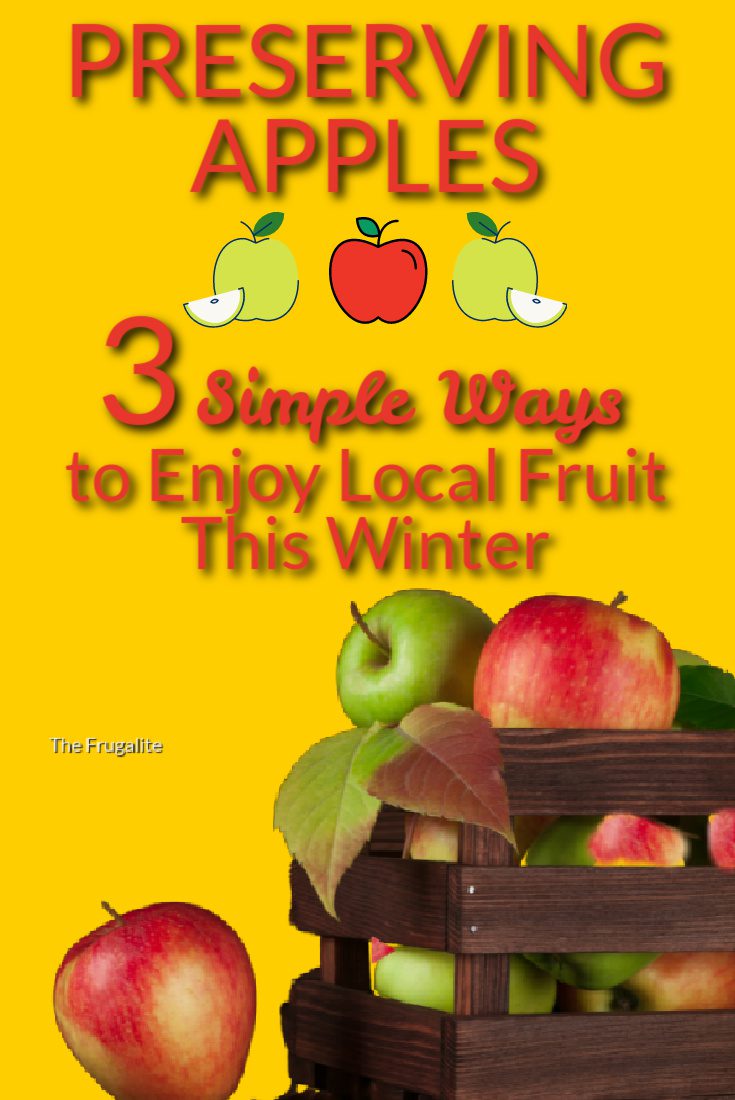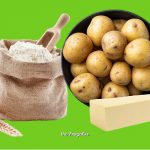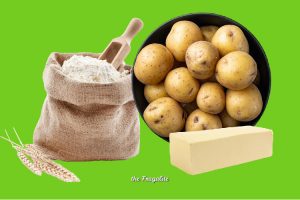(Psst: The FTC wants me to remind you that this website contains affiliate links. That means if you make a purchase from a link you click on, I might receive a small commission. This does not increase the price you’ll pay for that item nor does it decrease the awesomeness of the item. ~ Daisy)
By the author of The Ultimate Guide to Frugal Living and What to Eat When You’re Broke
Harvest season is winding down, and it’s apple time. I pulled out The Prepper’s Canning Guide, and now my house smells like apple cinnamon potpourri and I couldn’t be happier about it! Frugalites are big on seasonal food and also love preserving our own.
A visit to a you-pick orchard or farm stand is a great way to spend a fall afternoon if you don’t happen to have an apple tree in your backyard. You can often get the best deals at the end of the season. You can also do this with a score from the last-day-of-sale rack at the grocery store.
The nutritional benefits of apples
The old adage goes, “An apple a day keeps the doctor away.” Here are a few reasons why this is true!
- One medium apple (about 3″ in diameter) contains about 95 calories, no fat, 25 grams of carbohydrates, and more than 4 grams of fiber.
- The phytonutrients in apples can positively affect insulin production to help regulate blood sugar.
- The consumption of apples can have a positive influence on the bacterial balance of the digestive tract.
- Much of the apple’s nutrients can be found in the skin, particularly beneficial polyphenols such as quercetin.
- Apples contain substantial amounts of Vitamin C, the B vitamins, and potassium.
- Regular consumption of apples has been proven to reduce the risk of cancer, diabetes, heart disease, Parkinson’s disease, and Alzheimer’s.
Method #1: Storing apples in a cold room
If you have the right location, you can store apples for several months. Here are some tips on keeping fresh apples over the winter:
- Choose the very best apples from your bushels. Opt for firm apples with unblemished, unbruised skin.
- The thicker skinned, more tart varieties will stay good for the longest time.
- Wrap them individually in newspaper to keep them from being in direct contact with one another.
- Place them loosely packed in a cardboard box.
- Don’t store them near potatoes. Potatoes release a gas that causes apples to spoil more quickly.
- Store them at 35-40 degrees Fahrenheit for the longest shelf life. Good locations are basements, root cellars, or unheated pantries.
Method #2: Making apple chips
In theory, apple chips are a great way to preserve apples without the need for a cold cellar. In reality, they are a delightful snack that will be gone within a week, no matter how many you make.
You can make these with no added sugar and cinnamon, but we truly love this as a sweet treat. If it helps your conscience, it contains far less than any commercial fruit treat you could buy.
Ingredients:
- Apples (duh)
- Lemon juice (optional)
- Organic sugar
- Cinnamon
Directions:
- Cut the apples into 1/8 inch thick slices.
- If you are concerned about discoloration, you can toss the slices in lemon juice. I don’t worry about the discoloration because the cinnamon makes them look brownish anyway. I don’t normally use lemon juice, but you can if you want to.
- In a bowl, mix sugar and cinnamon in the ratio that pleases you. I use about a 1/4 cup of sugar to a teaspoon of cinnamon, and replenish it when necessary.
- Toss the slices in your sugar and cinnamon mixture.
There are two ways you can dry them from here on out. You can use a dehydrator or your oven. I use a 9-tray Excalibur dehydrator because I do a lot of dehydrating.
Dehydrator instructions:
- Place the slices in a single layer on your dehydrator tray. I use these inexpensive dehydrator sheets to line my trays for easy clean-up.
- If your dehdrator doesn’t have temperature settings, dry the slices on low for about 20 hours.
- If you do have temperature settings, dry the slices at 135 degrees for about 10 hours.
- When you take them out, they won’t seem crispy, but if you let them sit before putting them in a jar, they’ll crisp right up in a couple of hours.
Oven instructions:
- Line cookie sheets with parchment paper.
- Set your oven for 200 degrees.
- Place apples on the parchment paper in a single layer.
- Dry the apple slices for 4-6 hours, or until almost crisp.
- When you take them out, they won’t seem crispy, but if you let them sit before putting them in a jar, they’ll crisp right up in a couple of hours.
In theory, these would be great lunch box treats, but unless you hide them, they won’t last that long! After they’ve cooled completely, put them in a Mason jar or gallon Ziplock bag.
Method #3: Canning to preserve apples
Canning is my favorite way to preserve anything, and apples are no exception. Below, find the links to thorough instructions for canning apples. Because fruit is naturally high in acid, these can all be preserved using a water bath canner.
This apple sauce is pure enough to use for baby food, because it contains only two ingredients: apples and water. With it, you will get the flavor of fresh, delicious apples all winter long. I incorporate the peels into my apple sauce because it’s where the fiber and vitamins lie. This apple sauce can also be used as an ingredient in baking or cooking because it’s completely neutral.
Here’s a twist on ordinary apple sauce. There’s still no sugar, but it’s jazzed up with cinnamon, ginger, allspice, and cloves. Your house will smell a-flippin-mazing while this is on the stove. Save the cooking liquid for the next recipe!
Spiced apple toddy
You will definitely thank me for this one! After making spaced apple sauce, the reserved liquid is the perfect basis for a hot winter beverage. All of the warming spices that were added will making you feel toasty from the inside out. This is also a nice treat for someone suffering from a cold or flu. Waterbath can your liquid along with your apple sauce or for 20-30 minutes, depending on altitude.
How do you preserve apples?
What is your favorite method for preserving apples for the winter? Please share in the comments below!
References
The canning recipes are from my book, The Prepper’s Canning Guide.
About Daisy
Daisy Luther is a coffee-swigging, adventure-seeking, globe-trotting blogger. She is the founder and publisher of three websites. 1) The Organic Prepper, which is about current events, preparedness, self-reliance, and the pursuit of liberty; 2) The Frugalite, a website with thrifty tips and solutions to help people get a handle on their personal finances without feeling deprived; and 3) PreppersDailyNews.com, an aggregate site where you can find links to all the most important news for those who wish to be prepared. Her work is widely republished across alternative media and she has appeared in many interviews.
Daisy is the best-selling author of 5 traditionally published books, 12 self-published books, and runs a small digital publishing company with PDF guides, printables, and courses at SelfRelianceand Survival.com You can find her on Facebook, Pinterest, Gab, MeWe, Parler, Instagram, and Twitter.












4 thoughts on “Preserving Apples: 3 Simple Ways to Enjoy Local Fruit This Winter”
Apple butter, apple sauce, apple juice, apple cider, apple vinegar, dried apple chips, apple pies , apple bread, apple cakes, caramel apples, apple toddy, apple betty, apple dumplings, baked apples, and apple jelly. I haven’ t tried this yet, but I bet if wine yeast and sugar added to apple peels and cores, we would have apple wine.
baked (gravenstein if you can get it–freeze when in season) apple in your best pastry. brown sugar in the core with 1 raspberry plugging the core hole and a teaspoon of butter and a dash of cinnamon over that. brush the crust with a sugar and milk glaze to enhance. bake at 350-375 until the apple is soft when poked and the crust is browning and flaky. maybe 30-40 min.
Great article. I make A LOT of applesauce. No need to peel or core! *Simply cut off the blossom end*, (this is the BITTER end), quarter and add to a large stockpot to which some water has been added. Add additional water as needed throughout cooking. Cook at a low temperature. Stir with flat wooden spoon to prevent sticking. No sugar needed. Cooking the core, skins and seeds into your mash is highly nutritional. (The seeds have an anti-cancer benefit.) When your mash is done, strain. (use either large sieve or rotation-style strainer) It’s now ready to freeze. If canning, reheat the sauce on low heat and prepare jars. My water bath canner recipe calls for 20 minutes for either quarts or pints. I’ve been doing this for 30 years and have never had any fails 🙂 This is the old-timers’ recipe from our great grandmother. 🙂
I thought the seeds had arsenic in them.
Debbie in MA